
Calvinia was founded on the Farm-'Hoogekraal', in 1845. This property was purchased by the Dutch Reformed Church in order to establish a parish for the Town- Hantam, located in the Karoo. (The name Hantam; has its origins with the Khoi people and it is believed that the name refers to "the hill where the' red nut sedge' grows".)
However, a Protestant minister, Reverend N Hofmeyr arrived in the Town in, 1851. The Village’s name was then changed to Calvinia. This was to honour the Protestant theologian and reformer: 'John Calvin'. During the Anglo Boer War in 1901 the Village was attacked by raiding Boer Commandos. Abraham Esau, a patriotic Coloured blacksmith who was loyal to the British. A force of 70 locals had gathered to defend the Town, against the raiding Boer Commando. The Boers ripped down the Union Jack upon entering the Town and tore it up, (The torn flag is on display in the Calvinia Museum.)
Abraham Esau earned the hatred of the Boers by demonstrating an active loyalty to Britain and by defiantly asserting the limited civic rights enjoyed by Coloureds in the Cape Colony at the time. Abraham Esau was captured by the Boers, placed in leg irons and tied between two horses. The horses dragged Esau out of the Town where he was beaten and finally executed by one of the Boer Commandos, Stephanus Strydom.
In the early twentieth Century a sizable Jewish Community made its home in Calvinia and contributed significantly to the commercial development of the Town. A Jewish Synagogue was built and opened in the Town in, 1920. Over the years the Jewish Community dwindled and ultimately the Synagogue closed and was converted into the Calvinia Museum.
Calvinia has developed as the centre for a vast Agricultural District and the building of the railway, linked Calvinia with Hutchinson by, 1917. Today Calvinia has a well preserved Architectural Heritage that provides an interesting window on its past.
Calvinia’s economy continues to revolve around wool and mutton farming. For many years the Railway Line was the primary means of transportation for the agricultural products from this remote corner of South Africa. Sadly the Railway has fallen into disuse. A fine example of a Class 24 steam locomotive, built in 1949 by the North British Locomotive Company, which was used extensively on this line, now stands in the garden of the Calvinia Museum as a forlorn reminder of the golden age of steam.
https://plants.ces.ncsu.edu/plants/cyperus-rotundus/
https://www.wheretostay.co.za/topic/4394-grave-of-abraham-esau
https://www.britannica.com/place/Great-Karoo#:~:text=Great%20Karoo%2C%20Karoo%20also%20spelled,and%20the%20Swartberg%20(south).https://www.tripadvisor.co.za/Attractions-g1566626-Activities-Calvinia_Northern_Cape.html
https://www.sa-venues.com/destinations/northerncape/calvinia/attractions/
https://local.infobel.co.za/ZA100383298-0273419040/abraham_esau_hospital-newtown.html